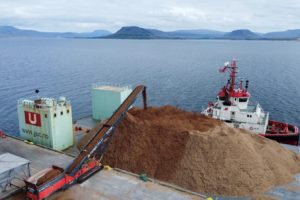A large phytoplankton bloom [light blue] in the Barents Sea in July 2018, captured by a NOAA satellite. Credit: NOAA NOAA Environmental Visualization Laboratory
As global temperatures rise and the Arctic Ocean becomes increasingly sea ice-free, phytoplankton blooms are expanding northward at a rate of 1 degree of latitude — or 69 miles — per decade, moving into waters where they have never been seen before, according to a new study in the journal Geophysical Research Letters.
Phytoplankton, which form the base of the marine food web, have always been present in the Arctic Ocean, but generally in very low levels. Scientists warn that blooms at higher latitudes could significantly disrupt the Arctic’s fragile marine ecosystem, as well as affect the fate of the Arctic Ocean as a carbon source or sink.
The study, led by Sophie Renaut, a PhD student at Laval University in Quebec, examined satellite photos for ocean color, a measure of phytoplankton biomass and primary productivity, to track blooms from 2003 to 2013. The researchers found that in the spring and summer, net primary productivity in the Arctic Ocean increased 31 percent over the decade. And blooms in the Barents and Kara seas expanded north 1 degree of latitude per decade, moving increasingly closer to the Arctic’s central basin.
“The polar regions — the Southern Ocean and the Arctic Ocean — they’re really important because they play a critical role in regulating the global climate,” Renaut said in a statement. “If sea ice disappears completely in summer in the Arctic Ocean, which is what we expect in some decades, it’s going to have an impact on the ecosystem, but also likely on the climate.”
Patricia Yager, a marine scientist at the University of Georgia who was not involved with the study, noted that as sea ice disappears earlier in the year, phytoplankton blooms will happen earlier in the spring, with major impacts to Arctic species.
“Such a mismatch in time could cause major changes to the Arctic food web, impacting not only the local animals and the people who live there, but also the global population of migrating animals who depend on these Arctic resources,” Yager said in a statement. “What happens in the Arctic does not stay in the Arctic.”
![A large phytoplankton bloom [light blue] in the Barents Sea in July 2018, captured by a NOAA satellite. Credit: NOAA](/assets/site/_400xAUTO_stretch_center-center/Phytoplankton-Bloom_20180730-barentsA-small.jpg)


